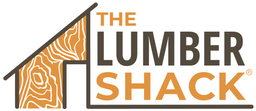
Should you leave or remove the bark on a live edge slab project? Some say you have to leave it to maintain the rustic, natural look. Some say you have to take it off because in the long run, it's more hassle than it's worth. The right answer to this question? Whatever fits your project and design the best!
We know that's not the most helpful answer, so we had our shop team put together some key points to consider when deciding this on your project:
First and foremost, do you like the bark look?
While live edge wood slab furniture has been known for its rustic charm, this design style isn't for everyone! We see more and more live edge pieces being used in modern design styles, where you'll typically see the bark being removed to allow for a smooth, flowing live edge rather than the bulkier appearance of the bark.
Next, what is the bark like?
Some wood types, such as red cedar or hickory, are known for having flakey bark that really just can't be salvaged. Most of this will come off during the drying process, but “stringy” pieces can get left behind and would need to be removed to allow a finish to properly seal the wood's edge.
Other wood types, such as walnut or oak, have a greater chance of holding onto their bark through the drying process. This gives you the opportunity to choose whether you keep this natural character, or expose the live edge underneath. If you choose to leave the bark, you will need to consider the additional finishing steps it will require to give it the longest life.

If you choose to leave the bark, be ready for a little more work!
Bark is prone to have loose or weak spots from different environmental factors, such as small bugs moving between the bark and the live edges or sap production at the time the tree was downed. This means to be sure your bark stays put, you will most likely have to do some additional stabilizing for a solid wood dining table with bark
Oils and traditional finishes like a Lacquer or Polyurethane are great for sealing the wood and offering protection, but they don't offer a strong enough bond to secure loose bark or fill in any gaps. The best bet to keep your bark secure? Epoxy! This is a material made to get into small areas, like gaps between the bark and slabs, and provide a strong bond to keep things in place. Epoxy can also be “painted” on the bark itself to help harden the outer sections.

Decide the bark isn't for you? Here's how to remove it:
Removing the bark is a fairly simple process! Here in our shop, we often use a chisel and a hammer, or a larger tool like the carpenter's draw knife in this image, to get the larger sections off the live edges. Any smaller pieces can often be removed with a grinder, wire brush, or even just some sanding!
Once the bark is off, you'll often see a darker color on the wood surface. This is just a layer of sap, dirt, and debris left behind by the bark and it is easily removed during the sanding process.

*Tip: We've found that if you want to keep the darker color on the edge, you can clean off any loose particles and then sand with a higher grit paper. This preps the edge to accept a finish and holds on to more of the darker coloring!
All in all, there's no true right or wrong answer when it comes to keeping or removing the bark. Do what you feel is best for your project!


